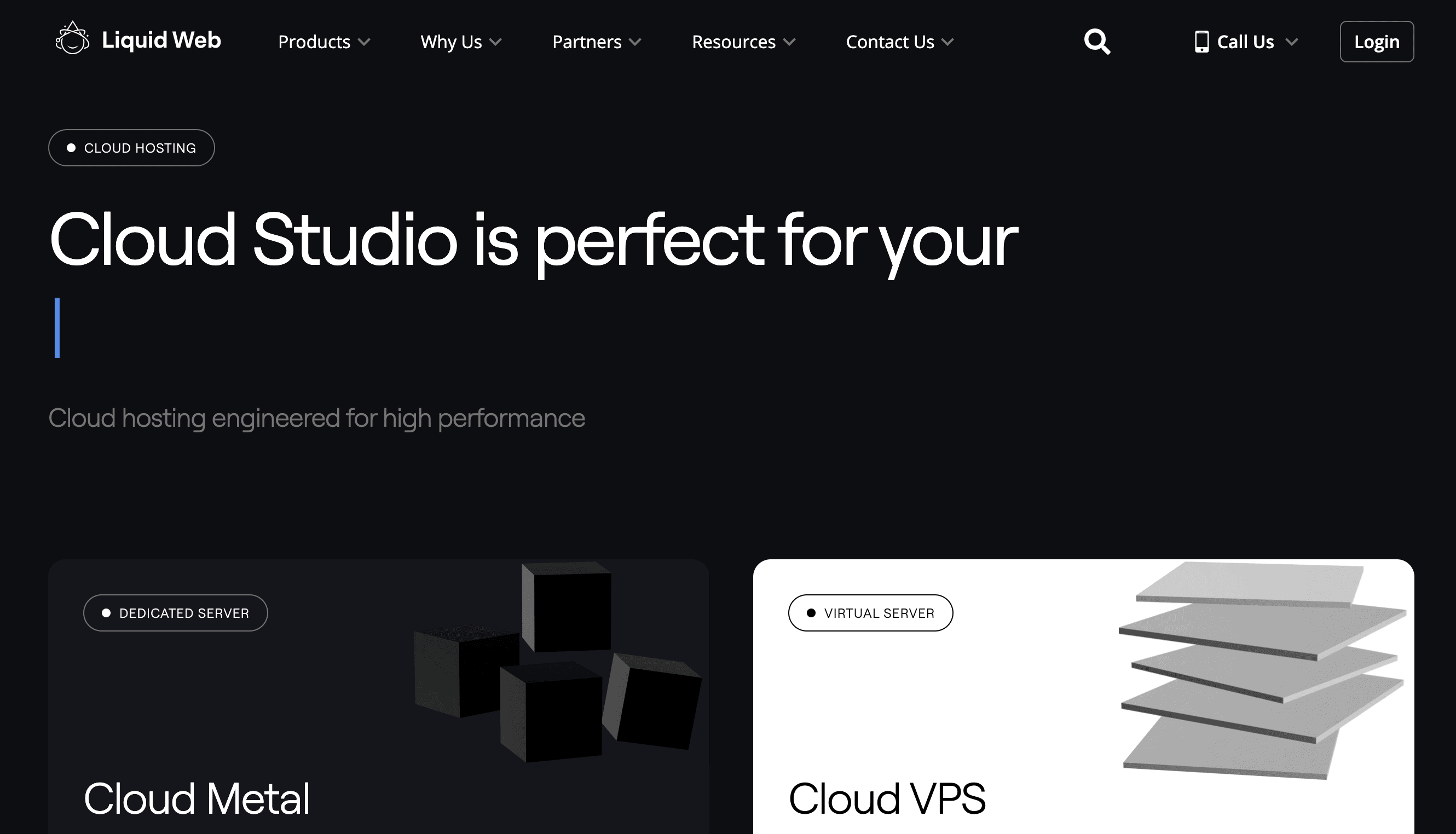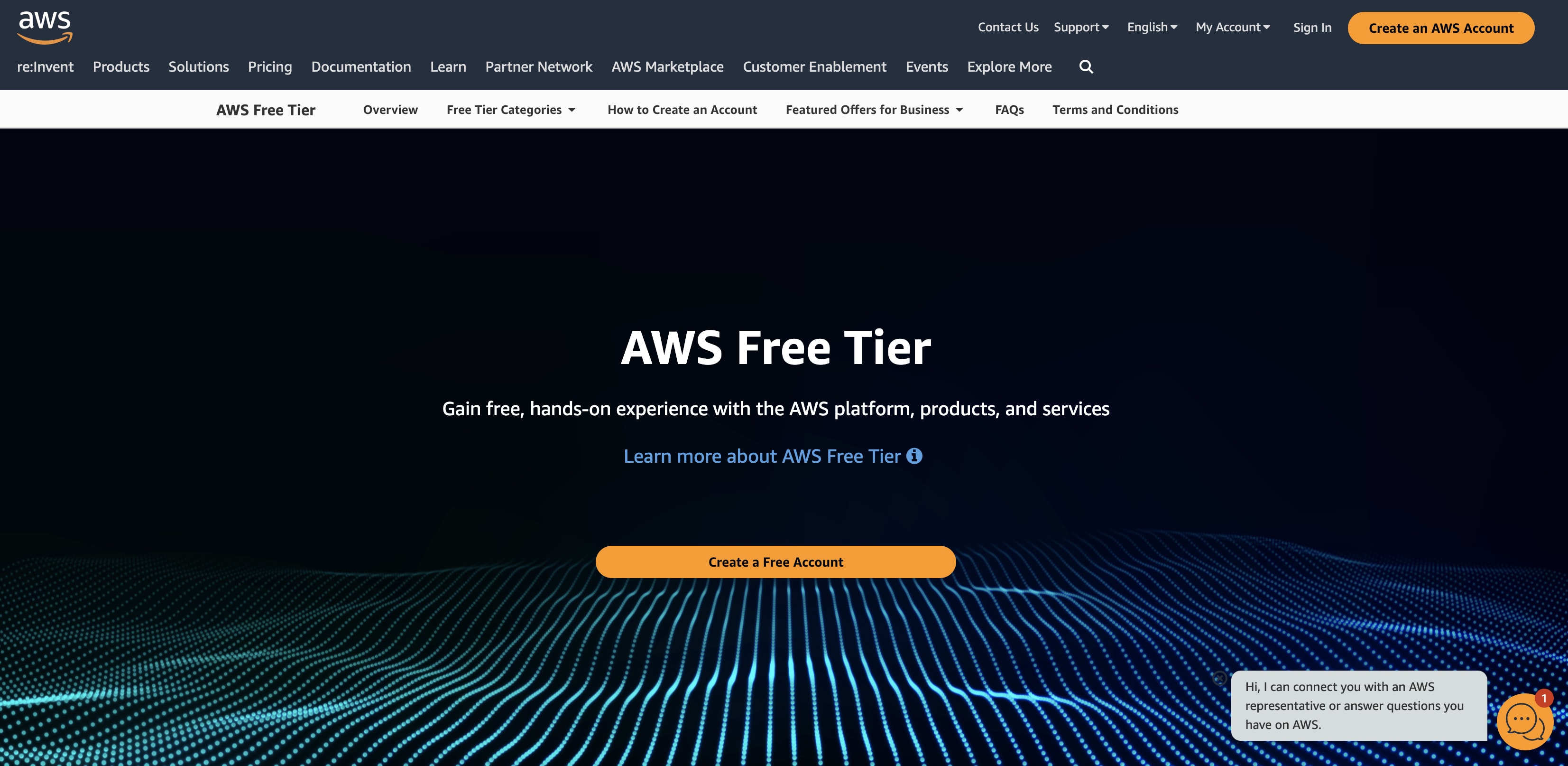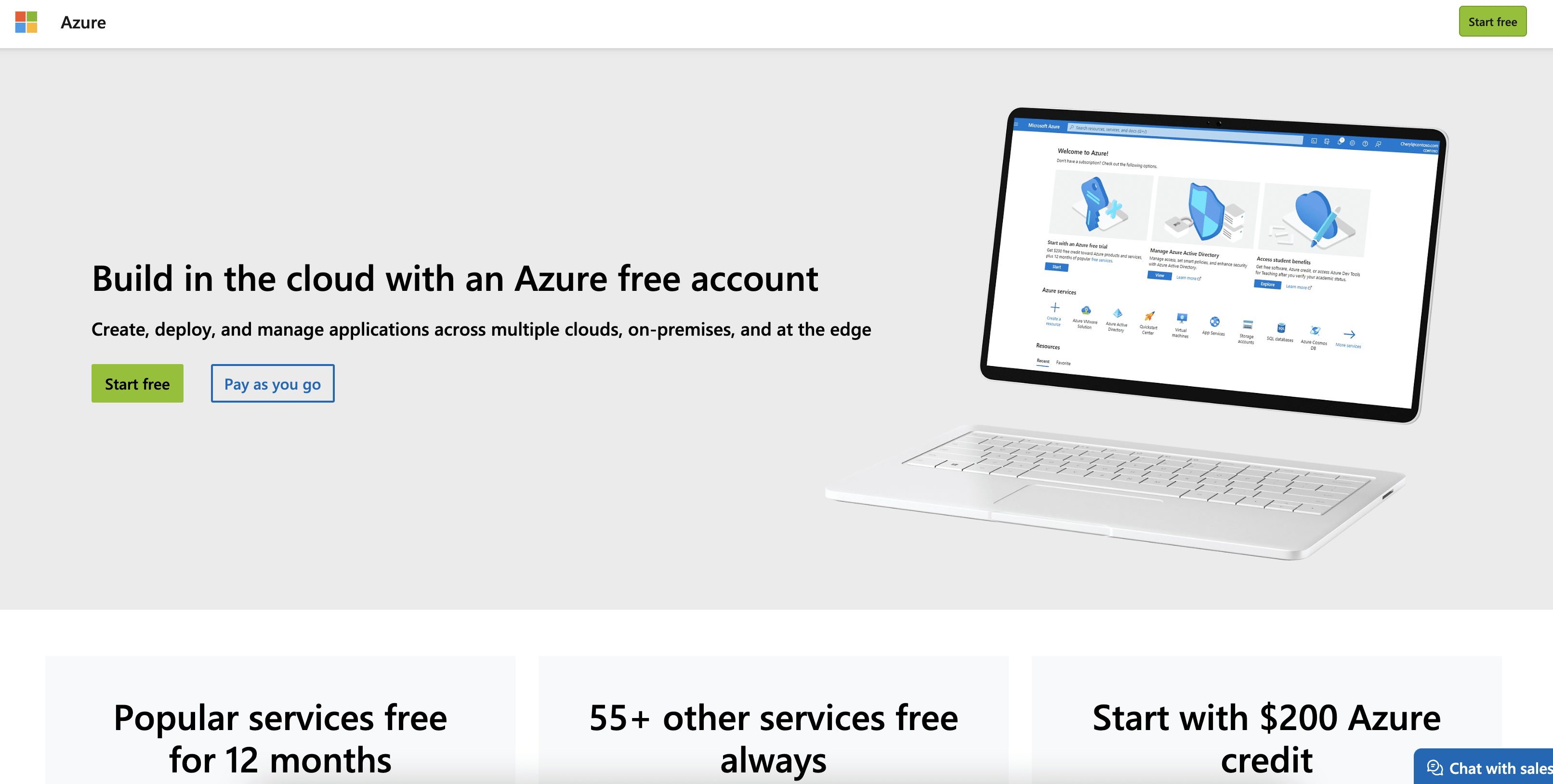AWS vs Azure vs Cloud Studio: Which is best?
Cloud computing offers a wide range of benefits over on-premise computing alternatives. These benefits are the main reason the expected growth in the cloud computing market size is a compound annual growth rate (CAGR) of 14.1% from 2023 to 2030.
Azure and AWS are currently two of the most popular cloud providers in the market. Nevertheless, other cloud solutions, such as Cloud Studio by Liquid Web, could serve as better alternatives for developers who need more simplified and reliable cloud services.
So which of these three should you choose? This guide will provide you with a detailed comparison of AWS vs Azure vs Cloud Studio to make it easier for you to choose.
Understanding Cloud Studio vs AWS vs Azure
Cloud Studio (by Liquid Web) overview

Cloud Studio by Liquid Web is a self-managed cloud hosting solution, available on-demand at an entry-level price point of $5 USD per month. It offers two major products, including Bare Metal Cloud and Cloud VPS Hosting. Both solutions can be deployed and customized instantly to align their resources with the needs of various applications.
What makes Cloud Studio particularly attractive is its software-agnostic nature. This enables it to seamlessly integrate into both new and existing applications or software deployments. Cloud Studio also streamlines the cloud hosting and deployment process, allowing for the hassle-free launching of apps without the need to navigate through an extensive array of services. Overall, this platform was designed with convenience, ease of use, and adaptability in mind.
Amazon Web Services (AWS) overview

AWS, as an Amazon subsidiary, boasts an extensive array of on-demand cloud computing solutions and APIs, functioning on a pay-as-you-go model. With a catalog comprising over 200 services, AWS presents a diverse range of offerings, including popular ones like Amazon EC2, AWS Lambda, RDS, S3, and DynamoDB.
Its standout feature lies in the flexibility and scalability it offers to users. It is often utilized alongside autoscaling to dynamically adapt to varying workloads. However, while it provides an extensive range of services, navigating and effectively utilizing these services might initially be overwhelming even for experienced developers.
Microsoft Azure overview

Azure, under Microsoft's management, is a robust cloud computing provider offering access, management, and development of applications and services across a global network of data centers. Similar to AWS, Azure also offers over 200 services, including popular ones, such as Azure Cosmos DB, Azure SQL Database, DevOps Server, Azure Functions, and Microsoft Entra ID.
Where Azure stands out is its strong compatibility with Microsoft's ecosystem. This makes it a preferred choice for users seeking seamless integration with their existing Microsoft-based infrastructure. This familiarity aids in reducing the learning curve and facilitates a more integrated cloud experience for businesses already invested in Microsoft's suite of services and products.
Cloud Studio vs AWS vs Azure comparison
In this section, we will dive deep into the different features and capabilities you will get with each product.
Ease of use
Cloud Studio distinguishes itself by simplifying the user experience. Since it offers two main products — Cloud Metal and Cloud VPS — users have a clear starting point. The platform is designed to be intuitive, making it an accessible choice for those looking for a straightforward cloud solution. It caters to users who prefer a user-friendly, uncomplicated setup process, enabling quick deployment and customization.
Azure, which is part of Microsoft's ecosystem, offers a familiar interface for users acquainted with Microsoft products. This familiarity streamlines the transition to the cloud for those with existing Microsoft-based infrastructures. This familiarity can significantly reduce the learning curve and allow for a more seamless integration into a Microsoft-powered environment.
AWS provides a wide range of services but is known for its complexity. While it offers a vast selection, the multitude of services might initially overwhelm users, especially those new to the platform. However, for those willing to invest time into understanding the platform, it provides depth and flexibility in its offerings.
Security
Cloud Studio places a strong emphasis on security, implementing various measures, such as threat intelligence and advanced host protection with services like ServerSecure. This proactive approach ensures that users have robust host and network protection, addressing potential vulnerabilities that could become detrimental if they’re ever exploited.
AWS prioritizes security by setting secure alternatives and configurations as default. This ensures a heightened level of privacy and security for its users. Its default settings aim to create a secure environment from the outset. AWS offers several security tools that you can leverage to beef up the security of your cloud resources. Such tools include AWS Identity and Access Management (IAM), Amazon GuardDuty, Amazon Macie, AWS CloudTrail, Amazon Inspector, and AWS Shield.
Azure utilizes Microsoft's Cloud Defender, an AI-powered solution that actively shields against evolving threats. While generally secure, certain services might not be entirely secure by default, potentially necessitating additional configuration to address specific security vulnerabilities. Azure also provides several security services and tools, including Azure Active Directory, Azure Firewall, Azure resource locks, and Azure Key Vault.
Pricing
Price is another crucial factor you must consider when choosing between these platforms.
Cloud Studio positions itself as the most cost-effective option, offering plans starting as low as $5 USD per month for the Cloud VPS hosting option. The Bare Metal Cloud option starts at $115 USD per month, but it gives you access to a lot more resources, including a 4-core CPU, 12 GB RAM, 394 GB storage, and up to 10,000 GB bandwidth. Cloud Studio provides the flexibility to gradually scale resources at any point to align with the needs of your application.
AWS and Azure operate on a pay-as-you-go model, allowing users to pay for the resources they use. This can be an advantage for short-term use cases but might be costly for developers who may need to use these resources for several weeks or months. Azure particularly benefits businesses already embedded in the Microsoft ecosystem since it helps them avoid additional license fees for Microsoft products, which you may have to pay if you choose AWS.
Azure’s billing structure, offering per-minute charges and diverse subscription plans, provides more precise and flexible pricing compared to AWS. However, it tends to become more expensive, especially as services scale up, potentially impacting a company's overall cloud costs.
Uptime
Cloud Studio boasts an annual uptime of 99.9992%, surpassing the sought-after benchmark of "five 9s" in availability required by mission-critical sites and applications. With AWS vs Azure, both claim a 99.99% uptime, which is also a high standard but slightly lower than Cloud Studio's uptime performance. While all platforms offer reliable uptime, Cloud Studio marginally stands out in this aspect, providing a slightly more robust track record for ensuring constant availability.
Customer support
Cloud Studio excels in offering highly responsive 24/7 support with remarkably short query response times, often within a few minutes. Its smaller scale also allows for a closer relationship with customers, providing a more personalized and attentive approach. Notably, its live chat support feature allows users to swiftly obtain quick solutions to their queries.
AWS and Azure also offer reliable customer support, typically accessible through email or various other channels. Azure tends to excel in customer service, often preferred over AWS due to its responsiveness and support quality. While both larger platforms offer comprehensive support, Cloud Studio's more intimate approach and quicker response times can be an advantage, particularly for those valuing prompt assistance.
Deploying applications
Cloud Studio streamlines the deployment process, offering a straightforward path for customizing servers and deploying apps. This includes selecting the server's location, operating system, and computing options. Users also have the flexibility of opting for fully or partially managed resources at an additional cost, tailoring the deployment process to their specific needs.
Azure and AWS present a more complex and time-consuming deployment process, especially for beginners. Azure offers a range of deployment options, such as cloud and container services, functions, batches, and app services, among others. Similarly, AWS provides options like Elastic Beanstalk, Batch, Lambda, and containers.
These platforms offer extensive flexibility in deploying applications but will usually require delving into documentation or tutorials to navigate through their services effectively. The trade-off for this complexity is the versatility and extensive options available for deploying apps.
Cloud Studio vs AWS vs Azure: Which is best?
Let’s explore the pros and cons of each of these cloud providers.
Cloud Studio pros and cons
Pros
- Ease of Use — Streamlined deployment, offering simplicity in setting up and deploying applications.
- Uptime — Exceptional uptime performance, boasting 99.9992% — ideal for mission-critical applications.
- Security — Emphasis on advanced host protection and vulnerability management, ensuring robust security measures.
- Customer Support — Highly responsive 24/7 support, ensuring a more personalized relationship with users.
- Pricing — Extremely cost-effective, starting at $5 USD per month with the flexibility to scale resources gradually.
Cons
- Scope of Services — While offering major cloud hosting solutions, the service options are narrower compared to larger providers.
- Market Presence — Smaller scale compared to AWS and Azure, potentially influencing perceived reliability for larger-scale applications.
AWS pros and cons
Pros
- Vast service offerings — An extensive suite of services providing flexibility and depth in cloud solutions.
- Scalability — AWS is known for its scalability, accommodating varied workloads.
- Global presence — A well-established global network with data centers across several regions.
Cons
- Complexity — Extensive services can be overwhelming and may require time to navigate, especially for new users.
- Costs — The pricing structure might become steep as services scale up, potentially leading to higher costs.
Azure pros and cons
Pros
- Microsoft integration — Seamless integration for those already using Microsoft products and services.
- Flexibility in deployment — Diverse deployment options for applications within the cloud infrastructure.
- Global network — Access to a global network of data centers.
Cons
- Cost — Tends to be more expensive, especially with scaling services.
- Default settings — Some services may not be entirely secure by default, potentially exposing vulnerabilities.
Summary – Cloud Studio vs AWS vs Azure
If you’re a developer who wants to swiftly deploy your apps in the least possible amount of time, Cloud Studio emerges as the ideal choice. It also offers exceptional uptime, a user-friendly deployment process, robust security measures, highly responsive customer support, and remarkable cost-effectiveness.
Of course, Azure and AWS are more popular options and offer a wide range of services and global infrastructure. However, Cloud Studio's emphasis on simplicity, security, personalized assistance, and competitive pricing make it the optimal solution for many developers.
Get started with Cloud Studio today
As discussed in this article, Azure and AWS offer greater flexibility, versatile computing resources, and services compared to Cloud Studio. However, these benefits come at a significantly higher cost and complexity. Cloud Studio emerges as the prime choice, especially for developers valuing ease of use and not necessarily requiring the extensive computing resources or specialized services provided by AWS and Azure platforms.
To get started with Cloud Studio, the first step is creating an account with Liquid Web, with the option to sign up using Google. After creating your account, choose between Bare Metal Cloud and Cloud VPS Hosting. You should then make a few more configurations, including choosing the server location, operating system, template, and hardware resources that meet your app’s needs, and you will be good to go.
The key distinction between Cloud Metal and Cloud VPS lies in flexibility. Cloud Metal grants more control over hardware to meet the unique needs of your application, even allowing the selection of the specific CPU model. On the other hand, Cloud VPS offers a more affordable option, enabling resource adjustments without requiring as many choices.

Chika Ibeneme
Chika Ibeneme is a Community Support Agent at The Events Calendar. He received his BA in Computer Science in 2017 from Northern Caribbean University and has over 5 years of technical experience assisting customers and clients. You can find him working on various WordPress and Shopify projects.
Keep up to date with the latest Hosting news.



